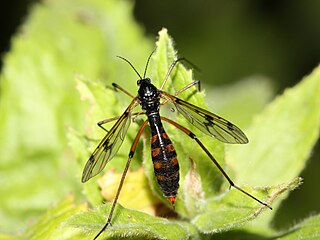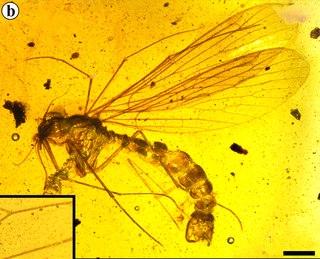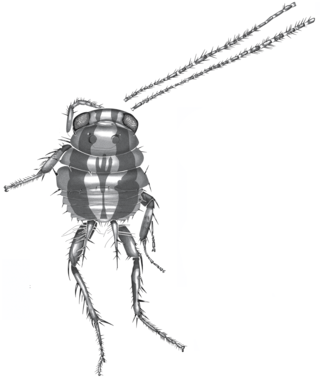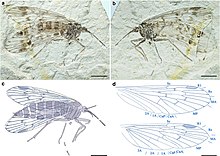
The Trachypachidae are a family of beetles that generally resemble small ground beetles, but that are distinguished by the large coxae of their rearmost legs. There are only six known extant species in the family, with four species of Trachypachus found in northern Eurasia and northern North America, and two species of Systolosoma in Chile and Argentina. They were much more diverse in the past, with dozens of described species from the Mesozoic.

Bittacidae is a family of scorpionflies commonly called hangingflies or hanging scorpionflies.

The Ptychopteridae, phantom crane flies, are a small family of nematocerous Diptera. Superficially similar in appearance to other "tipuloid" families, they lack the ocelli of the Trichoceridae, the five-branched radial vein of the Tanyderidae, and the two anal veins that reach the wing margins of the Tipulidae. They are usually allied with the Tanyderidae based on similarities of the mesonotal suture, this group being called the Ptychopteromorpha.

The Tettigarctidae, known as the hairy cicadas, are a small relict family of primitive cicadas. Along with more than 20 extinct genera, Tettigarctidae contains a single extant genus, Tettigarcta, with two extant species, one from southern Australia and one from the island of Tasmania. Numerous fossil species have been described from the Late Triassic onwards. Tettigarcta are the closest living relatives of the true cicadas.

Osmylidae are a small family of winged insects of the net-winged insect order Neuroptera. The osmylids, also called lance lacewings, stream lacewings or giant lacewings, are found all over the world except North and Central America. There are around 225 extant species.

Coptoclavidae is an extinct family of aquatic beetles in the suborder Adephaga. The Coptoclavidae lived from the Late Triassic to the Early Cretaceous. Coptoclavidae is a member of the adephagan clade Dytiscoidea, which contains other aquatic beetles. Suggested reasons for their extinction to include the rise of teleost fish, or competition with Gyrinidae and Dytiscidae, which possess defensive secretions and sucking channels in the mandibles of larvae, which coptoclavids likely lacked. It has been suggested that the genus Timarchopsis and the subfamily Timarchopsinae are only distantly related to other coptoclavids based on cladistic analysis, with Timarchopsis being more closely related to geadephagans like carabids and trachypachids instead. Another study also suggested similarly for Coptoclavisca and possibly other coptoclaviscines.

Ithonidae, commonly called moth lacewings and giant lacewings, is a small family of winged insects of the insect order Neuroptera. The family contains a total of ten living genera, and over a dozen extinct genera described from fossils. The modern Ithonids have a notably disjunct distribution, while the extinct genera had a more global range. The family is considered one of the most primitive living neuropteran families. The family has been expanded twice, first to include the genus Rapisma, formerly placed in the monotypic family Rapismatidae, and then in 2010 to include the genera that had been placed into the family Polystoechotidae. Both Rapismatidae and Polystoechotidae have been shown to nest into Ithonidae sensu lato. The larvae of ithonids are grub-like, subterranean and likely phytophagous.
The Progonocimicidae are an extinct family of true bugs in the suborder Coleorrhyncha. Progonocimicidae fossils have been found in Europe, Asia, Australia, and South America.
Ademosynidae is an extinct family of beetles, known from the Late Triassic to Early Cretaceous. There are at least six genera and 11 species in Ademosynidae. Members of the family were small oval beetles, with a length generally smaller than 1 cm. Characteristics of the family include a pronotum without anterior angles and a rounded anterior margin, and elytra with 9–12 punctate striae. The systematic position of the family within the order Coleoptera is currently uncertain: they can be considered early examples of the suborder Polyphaga, or unusual examples of Archostemata.

Permopsocida is an extinct order of insects known from the Early Permian to the Mid-Cretaceous. It is part of Paraneoptera, alongside bark lice, bugs and thrips. Within Paraneoptera it is considered to be closer to the clade containing bugs and thrips rather than bark lice, with an estimated divergence during the Late Carboniferous. The group was first named as a suborder by Robert John Tillyard in 1926, and was raised to a full order by Huang et al. in 2016. It is currently divided up into three families, Psocidiidae which is known from the Permian to Liassic. Permopsocidae which is only known from the Permian, and Archipsyllidae, which is known from the Late Triassic to mid-Cretaceous (Cenomanian). While most members of the group are known from compression fossils, several members of Archipsyllidae are 3 dimensionally preserved in Burmese amber, which has helped clarify the morphology and phylogenetic position of the group. The morphology of the mouthparts suggests that they were capable of suction feeding and chewing, with preserved angiosperm pollen grains in the gut of Psocorrhyncha suggesting that at least some members of the group were pollenivorous.

Pseudopolycentropodidae is an extinct family of scorpionflies known from the Mesozoic. Fossils are known from the Middle Triassic (Anisian) to the early Late Cretaceous (Cenomanian). It is part of Mesopsychoidea, a group of scorpionflies with siphonate proboscis. They are suggested to have been nectarivores, feeding off the liquid pollination drops and acting as pollinators for now extinct insect pollinated gymnosperms such as Bennettitales.

Dermapteridae is an extinct family of earwigs known from the Late Triassic to Mid Cretaceous, it is part of the extinct suborder Archidermaptera, alongside Protodiplatyidae and Turanovia. It was first named as a subfamily by Vishniakova in 1980, and elevated to family status by Engel in 2003 without discussion.

Blattulidae is an extinct family of cockroaches known from the Triassic to the Late Cretaceous. Their distinguishing characteristics include "forewing has long Sc, regular venation with distinct intercalaries and hindwing has simple CuP, branched A1."
Mesoblattinidae is an extinct family of cockroaches known from the Mesozoic. It was formerly considered a wastebasket taxon for Mesozoic cockroaches, but the family has subsequently been better defined, with many taxa transferred to Caloblattinidae. It is considered to have close affinities with Blattidae and Ectobiidae, as well as possibly Blaberidae. The family first appeared by the Early Jurassic. They are considered to represent amongst the oldest groups of modern cockroaches, and like them are thought to have laid oothecae.

Procercopidae is an extinct family of froghoppers. They are known from the Early Jurassic to early Late Cretaceous of Eurasia. They are one of two main families of Mesozoic froghoppers alongside Sinoalidae. Procercopidae are considered to be the ancestral group from which modern froghoppers are derived.

Necrotauliidae is an extinct family Mesozoic Amphiesmenoptera. While previously considered a paraphyletic grouping of "basal Trichoptera, basal Lepidoptera, and advanced stem-Amphiesmenoptera", they have recently been considered early diverging caddisflies. Other authors have considered them to be basal amphiesiopterans.
Lophioneurida is an extinct order of Thysanoptera, dating from the Carboniferous to the Cretaceous. It is likely paraphyletic, with modern thrips having evolved from members of the group.

Orthophlebiidae is an extinct family of scorpionflies known from the Triassic to Cretaceous, belonging to the superfamily Panorpoidea. The family is poorly defined and is probably paraphyletic, representing many primitive members of Panorpoidea with most species only known from isolated wings, and has such been considered a wastebasket taxon.
Protorthophlebia is an extinct genus of scorpionflies, known from the Triassic and Jurassic periods of Eurasia. It was originally considered a member of the family Orthophlebiidae, but was later placed as the only genus within the family Protorthophlebiidae within the superfamily Panorpoidea.
Geinitziidae is an extinct family of polyneopteran insects, known from the Permian to Cretaceous. They are currently considered to be members "Grylloblattida" a poorly defined group of extinct insects thought to be related to modern ice crawlers (Grylloblattidae). Other authors place them in the extinct order Reculida. Unlike modern ice crawlers, which are wingless, they had large wings, bearing a superficial resemblance to cockroaches, and are thought to have been day-active above ground predators.














